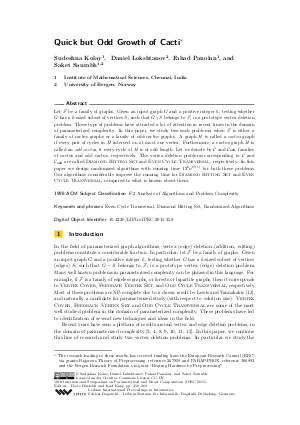Quick but Odd Growth of Cacti
Authors Sudeshna Kolay, Daniel Lokshtanov, Fahad Panolan, Saket Saurabh
-
Part of:
Volume:
10th International Symposium on Parameterized and Exact Computation (IPEC 2015)
Part of: Series: Leibniz International Proceedings in Informatics (LIPIcs)
Part of: Conference: International Symposium on Parameterized and Exact Computation (IPEC) - License:
 Creative Commons Attribution 3.0 Unported license
Creative Commons Attribution 3.0 Unported license
- Publication Date: 2015-11-19
File

PDF
LIPIcs.IPEC.2015.258.pdf
- Filesize: 0.49 MB
- 12 pages
Document Identifiers
Subject Classification
Keywords
- Even Cycle Transversal
- Diamond Hitting Set
- Randomized Algorithms
Metrics
- Access Statistics
-
Total Accesses (updated on a weekly basis)
0PDF Downloads0Metadata Views
Abstract
Let F be a family of graphs. Given an input graph G and a positive integer k, testing whether G has a k-sized subset of vertices S, such that G\S belongs to F, is a prototype vertex deletion problem. These type of problems have attracted a lot of attention in recent times in the domain of parameterized complexity. In this paper, we study two such problems; when F is either a family of cactus graphs or a family of odd-cactus graphs. A graph H is called a cactus graph if every pair of cycles in H intersect on at most one vertex. Furthermore, a cactus graph H is called an odd cactus, if every cycle of H is of odd length. Let us denote by C and C_{odd}, families of cactus and odd cactus, respectively. The vertex deletion problems corresponding to C and C_{odd} are called Diamond Hitting Set and Even Cycle Transversal, respectively. In this paper we design randomized algorithms with running time 12^{k}*n^{O(1)} for both these problems. Our algorithms considerably improve the running time for Diamond Hitting Set and Even Cycle Transversal, compared to what is known about them.
Cite As Get BibTex
Sudeshna Kolay, Daniel Lokshtanov, Fahad Panolan, and Saket Saurabh. Quick but Odd Growth of Cacti. In 10th International Symposium on Parameterized and Exact Computation (IPEC 2015). Leibniz International Proceedings in Informatics (LIPIcs), Volume 43, pp. 258-269, Schloss Dagstuhl – Leibniz-Zentrum für Informatik (2015)
https://doi.org/10.4230/LIPIcs.IPEC.2015.258
BibTex
@InProceedings{kolay_et_al:LIPIcs.IPEC.2015.258,
author = {Kolay, Sudeshna and Lokshtanov, Daniel and Panolan, Fahad and Saurabh, Saket},
title = {{Quick but Odd Growth of Cacti}},
booktitle = {10th International Symposium on Parameterized and Exact Computation (IPEC 2015)},
pages = {258--269},
series = {Leibniz International Proceedings in Informatics (LIPIcs)},
ISBN = {978-3-939897-92-7},
ISSN = {1868-8969},
year = {2015},
volume = {43},
editor = {Husfeldt, Thore and Kanj, Iyad},
publisher = {Schloss Dagstuhl -- Leibniz-Zentrum f{\"u}r Informatik},
address = {Dagstuhl, Germany},
URL = {https://drops.dagstuhl.de/entities/document/10.4230/LIPIcs.IPEC.2015.258},
URN = {urn:nbn:de:0030-drops-55883},
doi = {10.4230/LIPIcs.IPEC.2015.258},
annote = {Keywords: Even Cycle Transversal, Diamond Hitting Set, Randomized Algorithms}
}
Author Details
References
-
Ann Becker, Reuven Bar-Yehuda, and Dan Geiger. Randomized algorithms for the loop cutset problem. (JAIR), 12:219-234, 2000.

-
Hans L. Bodlaender, Fedor V. Fomin, Daniel Lokshtanov, Eelko Penninkx, Saket Saurabh, and Dimitrios M. Thilikos. (meta) kernelization. In FOCS 2009, pages 629-638, 2009.

-
Yixin Cao. Unit interval editing is fixed-parameter tractable. In ICALP 2015, volume 9134 of LNCS, pages 306-317. Springer, 2015.

-
Yixin Cao and Dániel Marx. Interval deletion is fixed-parameter tractable. ACM Transactions on Algorithms, 11(3):21:1-21:35, 2015.

-
R. Diestel. Graph Theory. Springer, Berlin, second ed., electronic edition, February 2000.

-
Samuel Fiorini, Gwenaël Joret, and Ugo Pietropaoli. Hitting diamonds and growing cacti. In IPCO 2010, pages 191-204, 2010.

-
Fedor V. Fomin, Daniel Lokshtanov, Neeldhara Misra, Geevarghese Philip, and Saket Saurabh. Hitting forbidden minors: Approximation and Kernelization. In Thomas Schwentick and Christoph Dürr, editors, STACS 2011, volume 9 of (LIPIcs), pages 189-200, Dagstuhl, Germany, 2011. Schloss Dagstuhl-Leibniz-Zentrum fuer Informatik.

-
Fedor V. Fomin, Daniel Lokshtanov, Neeldhara Misra, and Saket Saurabh. Planar f-deletion: Approximation, kernelization and optimal FPT algorithms. In FOCS 2012, pages 470-479, 2012.

-
Fedor V. Fomin and Yngve Villanger. Subexponential parameterized algorithm for minimum fill-in. SIAM J. Comput., 42(6):2197-2216, 2013.

-
Archontia C. Giannopoulou, Bart M. P. Jansen, Daniel Lokshtanov, and Saket Saurabh. Uniform kernelization complexity of hitting forbidden minors. In ICALP 2015, volume 9134 of LNCS, pages 629-641. Springer, 2015.

-
Gwenaël Joret, Christophe Paul, Ignasi Sau, Saket Saurabh, and Stéphan Thomassé. Hitting and harvesting pumpkins. SIAM J. Discrete Math., 28(3):1363-1390, 2014.

-
Eun Jung Kim, Alexander Langer, Christophe Paul, Felix Reidl, Peter Rossmanith, Ignasi Sau, and Somnath Sikdar. Linear kernels and single-exponential algorithms via protrusion decompositions. In ICALP 2013, volume 7965 of LNCS, pages 613-624. Springer, 2013.

-
John M. Lewis and Mihalis Yannakakis. The node-deletion problem for hereditary properties is np-complete. J. Comput. Syst. Sci., 20(2):219-230, 1980.

-
Daniel Lokshtanov and M. S. Ramanujan. Parameterized tractability of multiway cut with parity constraints. In ICALP 2012, pages 750-761, 2012.

-
Pranabendu Misra, Venkatesh Raman, M. S. Ramanujan, and Saket Saurabh. Parameterized algorithms for even cycle transversal. In WG 2012, pages 172-183, 2012.

-
Carsten Thomassen. On the presence of disjoint subgraphs of a specified type. Journal of Graph Theory, 12(1):101-111, 1988.

